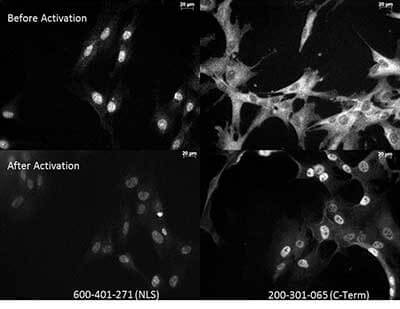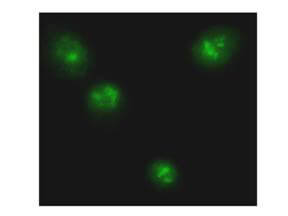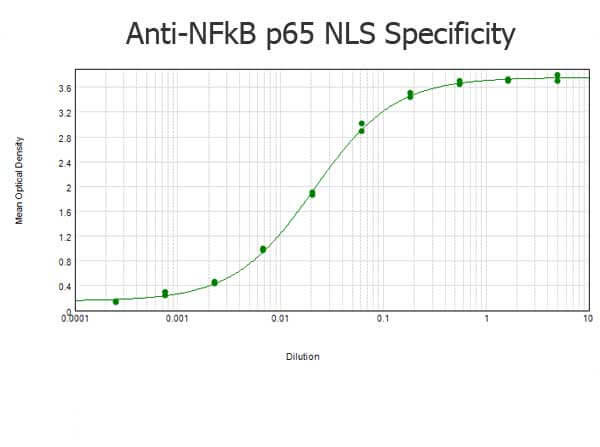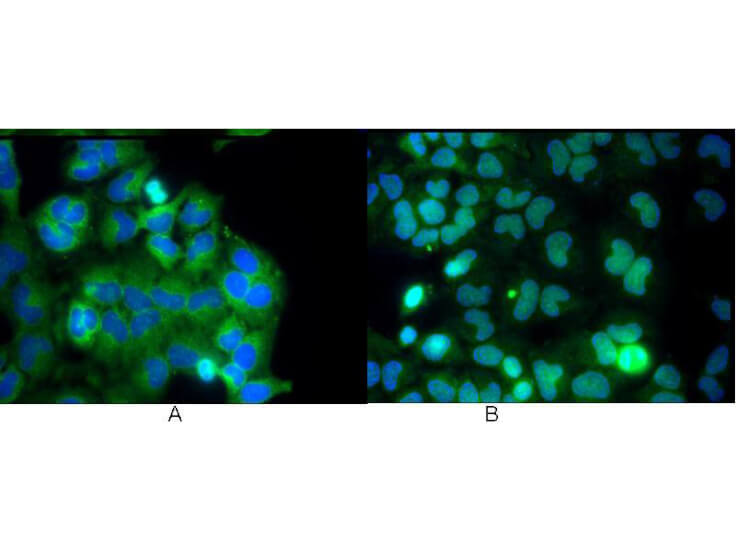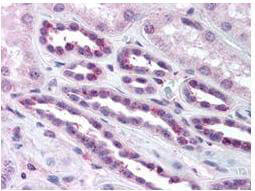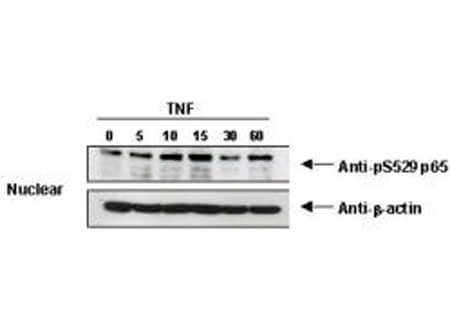Datasheet is currently unavailable. Try again or CONTACT US
NFkB p65 Antibody
Rabbit Polyclonal
6 References
600-401-271
100 µg
Liquid (sterile filtered)
WB, ELISA, IHC, IF, EMSA
Human
Rabbit
Shipping info:
$50.00 to US & $70.00 to Canada for most products. Final costs are calculated at checkout.
Product Details
Anti-NFKB p65 NLS specific (RABBIT) Antibody - 600-401-271
rabbit anti-NFKB p65 antibody, rabbit anti-p65 antibody, rabbit anti-NLS specific antibody, nuclear localization sequence, NFKB, NFkß, NF-kB, NF-kappaB, NFkappaB, Transcription factor p65, Nuclear factor NF-kappa-B p65 subunit, Nuclear factor of kappa light polypeptide gene enhancer in B-cells 3, RELA, NFKB3
Rabbit
Polyclonal
IgG
Target Details
RELA - View All RELA Products
Human
Conjugated Peptide
This antibody was purified from whole rabbit serum prepared by repeated immunizations with the NFkB p65 peptide corresponding to the NLS of the human protein conjugated to KLH using maleimide. A residue of cysteine was added to the amino terminal end to facilitate coupling.
This affinity-purified antibody is directed against the nuclear localization sequence (NLS) NLS of human p65 and is useful in determining its presence in various assays. The epitope recognized overlaps the NLS of the p65 subunit of the NFkB heterodimer. Therefore, the antibody selectively binds to the activated form of NFkB. Anti-NFkB p65 NLS may react non-specifically with other proteins.
Application Details
ELISA, IF, WB
EMSA, IHC
- View References
Anti-NFKB p65 antibody has been tested in ELISA, ICC, WB, and IF. NFkB gel shift assays are assembled in 20µl reactions containing 0.28 pmoles NFkB oligo in 10mM Tris (pH 7.6), 50 mM NaCl, 0.5 mM EDTA, 1.0 mM DTT, 10% glycerol. Some procedures specify the addition of 0.05% NP-40. When using purified protein, 250-300 ng should be sufficient to produce a gel shifted complex, while 10µg HeLa nuclear extract is utilized. The gel shift reactions are then incubated at room temperature for 30 minutes. The complexes are resolved on Tris-Glycine acrylamide gels. Loading dye containing bromophenol blue and xylene cyanol should be added to the negative control reaction only, as these dyes can increase the dissociation of the NFkB complexes. When using HeLa nuclear extract as the source of binding proteins, two sequence-specific gel-shifted complexes are expected, consisting of p50/p50 homodimers and p50/p65 heterodimers. For cells expressing p52, p50, and p65, as many as four sequence-specific gel-shifted complexes could be observed (p52/p52, p50/p50, p52/p65, p50/p65), and if high levels of p65 are present, the p65/p65 homodimer may also be weakly detected. The following reagents have been observed to enhance NFkB binding in vitro: millimolar amounts of GTP and ATP, spermine, spermidine, barium or calcium ions, and µM amounts of Co+3(NH3)6.
Formulation
1.0 mg/mL by UV absorbance at 280 nm
0.02 M Potassium Phosphate, 0.15 M Sodium Chloride, pH 7.2
0.01% (w/v) Sodium Azide
None
Shipping & Handling
Dry Ice
Store vial at -20° C prior to opening. Aliquot contents and freeze at -20° C or below for extended storage. Avoid cycles of freezing and thawing. Centrifuge product if not completely clear after standing at room temperature. This product is stable for several weeks at 4° C as an undiluted liquid. Dilute only prior to immediate use.
Expiration date is one (1) year from date of receipt.
NFkB was originally identified as a factor that binds to the immunoglobulin kappa light chain enhancer in B cells. It was subsequently found in non-B cells in an inactive cytoplasmic form consisting of NFkB bound to IkB. NFkB was originally identified as a heterodimeric DNA binding protein complex consisting of p65 (RelA) and p50 (NFKB1) subunits. Other identified subunits include p52 (NFKB2), c-Rel, and RelB. The p65, cRel, and RelB subunits are responsible for transactivation. The p50 and p52 subunits possess DNA binding activity but limited ability to transactivate. p52 has been reported to form transcriptionally active heterodimers with the NFkB subunit p65, similar to p50/p65 heterodimers. Low levels of p52 and p50 homodimers can also exist in cells. The heterodimers of p52/p65 and p50/p65 are regulated by physical inactivation in the cytoplasm by IkB-a. IkB-a binds to the p65 subunit, preventing nuclear localization and DNA binding. IkB-a binding masks the NFkB nuclear localization signal (NLS). A broad range of external stimuli lead to activation of NFkB and set off signaling cascades that ultimately converge on the IkB kinase (IKK) complex. Activated IKK specifically and directly phosphorylates IkB-a and this phosphorylation event targets IkB-a for degradation. As a consequence, NFkB NLS is uncovered and nuclear translocation occurs.
Regev D et al. (2022). Obstructive Sleep Apnea Syndrome In Vitro Model: Controlled Intermittent Hypoxia Stimulation of Human Stem Cells-Derived Cardiomyocytes. Int J Mol Sci.
Applications
IF, Confocal Microscopy
Haddad H et al. (2021). The Effect of Sera from Children with Obstructive Sleep Apnea Syndrome (OSAS) on Human Cardiomyocytes Differentiated from Human Embryonic Stem Cells. Int J Mol Sci.
Applications
IF, Confocal Microscopy
Hiyari S et al. (2018). Genomewide Association Study Identifies Cxcl Family Members as Partial Mediators of LPS-Induced Periodontitis. J Bone Miner Res.
Applications
IHC, ICC, Histology
Yu B et al. (2018). PGC-1α Controls Skeletal Stem Cell Fate and Bone-Fat Balance in Osteoporosis and Skeletal Aging by Inducing TAZ. Cell Stem Cell.
Applications
IF, Confocal Microscopy; IHC, ICC, Histology
Yu B et al. (2014). Wnt4 signaling prevents skeletal aging and inflammation by inhibiting nuclear factor-κB. Nat Med.
Applications
IF, Confocal Microscopy
Starkey JM et al. (2006). Diabetes-induced activation of canonical and noncanonical nuclear factor-kappaB pathways in renal cortex. Diabetes.
Applications
Supershift, Gel Shift, EMSA
This product is for research use only and is not intended for therapeutic or diagnostic applications. Please contact a technical service representative for more information. All products of animal origin manufactured by Rockland Immunochemicals are derived from starting materials of North American origin. Collection was performed in United States Department of Agriculture (USDA) inspected facilities and all materials have been inspected and certified to be free of disease and suitable for exportation. All properties listed are typical characteristics and are not specifications. All suggestions and data are offered in good faith but without guarantee as conditions and methods of use of our products are beyond our control. All claims must be made within 30 days following the date of delivery. The prospective user must determine the suitability of our materials before adopting them on a commercial scale. Suggested uses of our products are not recommendations to use our products in violation of any patent or as a license under any patent of Rockland Immunochemicals, Inc. If you require a commercial license to use this material and do not have one, then return this material, unopened to: Rockland Inc., P.O. BOX 5199, Limerick, Pennsylvania, USA.


